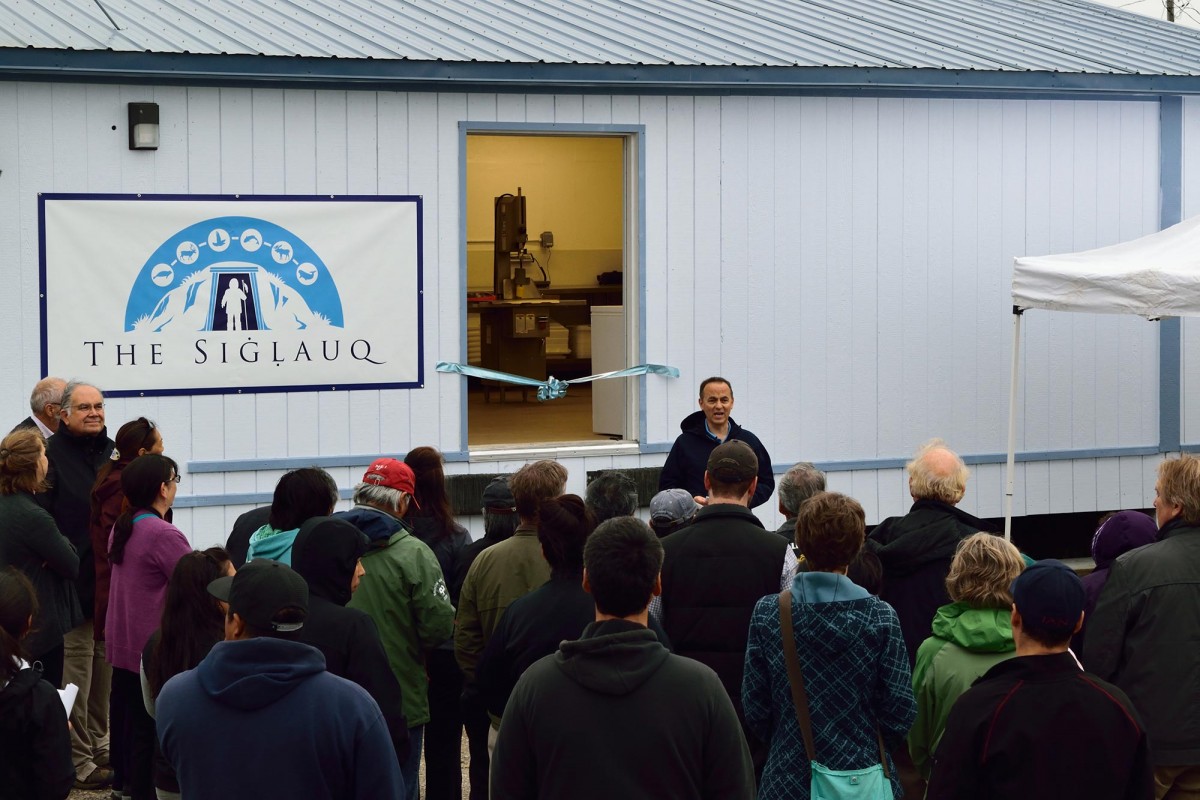By Kay Branch
The importance of traditional foods to Alaska Native and American Indian Elders cannot be overestimated. Imagine if in your last years you were prohibited from eating the foods that sustained you and your family for countless lifetimes; that in the place where you live there are no familiar smells of moose or sheefish boiling in the kitchen. Imagine someone said you had to eat turkey tetrazzini and spaghetti, not your comfort foods like muktuk or fish soup. That is just what happened in Kotzebue, Alaska in early 2012, when Utuqqanaat Inaat (place for elders) first opened. In the time since, the Farm Bill passed in Congress with an addendum to allow traditional foods to be served in senior care facilities and schools. Maniilaq staff, state and federal agency regulators, dietitians and statewide tribal health organizations have worked together to change regulations to allow for traditional foods to be prepared and served in the nursing home.
Traditional Alaska Native foods are some of the healthiest foods in the world. Moose and caribou meat are high in protein and low in saturated fat. Alaskan wild blueberries have more antioxidants than cultivated blueberries. Three ounces of bearded seal meat has 14mg of iron in it, 80% of the recommended daily value. You would have to eat 25 ounces of beef pot roast or 48 ounces of chicken nuggets to get that amount of iron. Seal oil, a cultural favorite, is an excellent source of omega-3 fatty acids, which aids in heart and mental health. A study that looks at dietary intake of Alaska Native people indicates that a higher proportion of nutrients come from the traditional foods, especially protein, iron and omega-3 fatty acids. The mean intakes of omega-3 from fish and sea mammals of participants in the study are over twenty times greater than the general U.S. population (Johnson, et.al.).
Being able to choose what you eat, what time you eat and making individual choices for your care is now known as “person centered care.” More and more it is becoming a way to improve quality for nursing home residents. According to the 2008 CMS Action Plan for Nursing Home Quality both person centered care and a facility’s participation in the culture change movement toward a more homelike environment are components surveyors can identify to help ensure quality. Culture change in nursing homes includes changing from a clinical, hospital like setting to one that more reflects where someone lived prior to entering the nursing home. Naturally this type of environment would include individual life choices.
Paul Hansen, hospital administrator for Maniilaq Association, said that, “for a long time it’s been a goal of our community to keep our elders at home as they got older and beyond the point where their families cannot take care of their medical needs. We had an assisted living center here but all our elders were being sent to Anchorage or Fairbanks for long-term care. It’s shameful that elders in the last year of their lives were separated from their families in the place they’ve lived their entire life. So we built a long-term care facility and it’s been operational for three years now, and it’s really all about the quality of life. We looked at all the building philosophies, and they all suggested making the clinical residential environment to be more “home like”. We wanted an open kitchen, so elders were not served [from the hospital kitchen] on carts; we wanted the noise, smells, and chatter of a home kitchen. We wanted the place to smell like moose stew.”
Steps to regulatory change:
Traditional Alaska Native foods are important to Alaska Native elders for a variety of cultural, social and nutritional reasons. However, these foods have not been widely used in long term care facilities due to a lack of familiarity and safety concerns. The road to defining and determining how Maniilaq could store and prepare traditional foods in their kitchen proved daunting. Staff had conversations with no less than eight federal and state agencies, which ended with conflicting and confusing areas of jurisdiction with no solid resolution. Before these conversations began, nursing homes were prohibited from serving traditional foods unless they were a part of an activities program or a potlatch. The barrier was a federal regulation known as F Tag 371. This rule required all foods to be obtained from an approved federal, state or local source, yet failed to define an approved source.
After numerous discussions, in the fall of 2014 federal agencies deferred their authority to the State of Alaska Department of Environmental Conservation (DEC). This placed the DEC in the position of being able to allow traditional foods to be served if the provisions of the Alaska Food Code (18 AAC 31.210) were being followed. Section 18AAC 31.205 speaks specifically to traditional foods. A kitchen which holds a permit from the state DEC can store and prepare the traditional foods without further inspection or certification. This decision opened the door for long term care facilities to serve traditional foods to their elders.
Maniilaq’s Hunter Support Program has operated under the leadership of Cyrus Harris since 1993. Through this program area hunters are provided support for supplies to hunt and fish. This small stipend allows village residents do what they’ve always done, support their elders. Following the discussions with the DEC, Maniilaq expanded this program and built a traditional food processing plant in Kotzebue where younger hunters will be trained by Harris regarding accepting fish and game; and looking for potential signs of illness or contamination of donated meat. As of April 2015, donated meat, fowl and fish will be processed and stored at the plant for cooking at Utuqqanaat Inaat. Elders in Kotzebue will also benefit from the bounty of the tundra. By defining “The Tundra as our Garden” Utuqqanaat Inaat is allowed to serve berries, herbs, and mushrooms fresh from the tundra.
In February 2015 Maniilaq invited state, federal and tribal partners for a two day meeting to tour the new processing facility and develop policies and procedures for the acceptance of donated traditional foods. The facility opened in April 2015.
The last step in the process was to receive approval from state and federal CMS nursing home surveyors to begin serving traditional foods. A special meeting was held with the State of Alaska Department of Environmental Conservation (DEC), the Licensure and Certification branch of Department of Health and Social Services, and leadership from Utuqqanaat Inaat. Consensus was achieved acknowledging DEC as the “Authority Having Jurisdiction” in determining an approved source for wild game, fish, and fowl.
April 23, 2015 was a ground breaking day for Utuqqanaat Inaat, and Elders in long term care facilities across Alaska. After years of deciphering the quagmire of regulations, Maniilaq received final approval from state and federal CMS surveyors to go forward with its program to serve traditional foods to their Elders.
Coming full circle:
There are still prohibited traditional foods such as walrus and polar bear because of the risk of trichinosis. Seal oil, an important source of vitamin A and a staple in the traditional coastal diet is still off limits due to the risk of botulism. However, the Alaska DEC has expressed interest in working together to create a standard safe process that addresses the botulism hazard. Lorida Lhotka of DEC stated, “We know it can be done safely because so many people across Alaska are making it. Unfortunately, there have also been people who have become very ill.” Therefore, developing a safe, documented process could reduce the barrier to serving seal oil. The Seal Oil Task Force will begin meeting in June 2015.
There are many traditional values among Alaska Native people living in Northwest Alaska: sharing, cooperation, respect for elders, respect for nature, hunter success, and responsibility to tribe. Maniilaq Association’s tribally owned and operated long-term care facility has now been able to institutionalize these values through a unique Hunter Support and Traditional Foods Programs intended to improve the quality of life of its Inupiat elders.
Eating traditional, subsistence foods is more than simply putting food into your mouth. It’s an experience. It’s taking that first bite of moose or caribou stew and enjoying the warmth, the goodness, and savoring the comfort that it brings. It is the smile on an elders’ face when she tastes the goose soup, something she hasn’t had in six years. Serving these foods is how we honor our elders.
Paul Hanson summed it up, “long term care is probably the most regulated industry out there, so I’m happy we’re all here talking about how, under that highly regulated environment, we can provide a home like environment for our elders and provide safe food that will positively impact our residents. This is not a market hunting program, its people hunting and donating and contributing to an elder’s well-being, and everyone gets satisfaction out of that.
“Maintaining the dignity and human integrity of every Elder is paramount in their care. By providing traditional foods for the Elders we are exercising their right to choose to maintain their cultural identity and dignity.” Helen McGaw, DON
With thanks to the hard work, dedication and commitment of Maniilaq and Utuqqanaat Inaat staff: Valdeko Kreil, Administrator; Cyrus Harris, Hunter; Helen McGaw, Director of Nursing; and Chris Dankmeyer, Environmental Health Manger.

